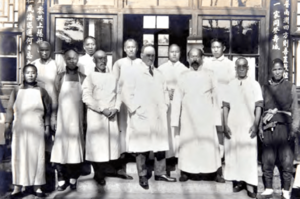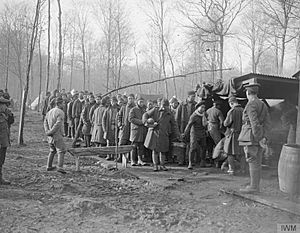George Douglas Gray facts for kids
Quick facts for kids
George Douglas Gray
|
|
|---|---|

Gray (centre) and the staff of the British Charitable Hospital in Peking.
|
|
| Born | 1872 Edinburgh, Scotland
|
| Died | 12 September 1946 (aged 73–74) |
| Education | University of Edinburgh |
| Known for |
|
| Medical career | |
| Profession | Physician |
| Institutions |
|
Lt. Col. George Douglas Gray CBE (1872 – 12 September 1946) was a Scottish doctor. He worked for the British Army in Africa and later as a medical officer for the British ambassador in Peking (now Beijing), China. He also ran the British Charitable Hospital there.
He played a big part in fighting a serious plague outbreak in China from 1910 to 1911. The Chinese government thanked him for his help. After this, he represented Britain at an important meeting about the plague in 1911.
During World War I, he led hospitals for the Chinese Labour Corps in France. After he retired, he wrote a book about the health benefits of soya beans. This book was inspired by his time in China.
Contents
Early Life and Education
George Gray was born in Edinburgh, Scotland, in 1872. His father was Robert Collie Gray. George studied medicine at the University of Edinburgh. He earned his first medical degrees in 1894. In 1897, he received his MD for a paper about sleep problems.
In 1900, he married Lucy Agnes. They had one son, Charles Gray, who was born in 1909. Charles later had a successful career in the Indian Army.
Medical Career and Service
Gray served in the British Army in Africa from 1894 to 1902. He worked in places like what is now Malawi and Kenya. He received medals for his service there. From 1897 to 1902, he was the main medical officer for the British Central Africa Administration.
From 1902 to 1926, he was the doctor for the British ambassador in Peking, China. He also managed the British Charitable Hospital there. He was highly praised for his work during the plague outbreak of 1910–1911. He was chosen to represent Britain at the International Plague Conference in Mukden in 1911.
World War I Service
During World War I, Gray joined the Royal Army Medical Corps. He became the commanding officer of hospitals for the Chinese Labour Corps in France. These hospitals were mainly located at Noyelles-sur-Mer. Under his leadership, one hospital grew from 300 beds to 1,040 beds in just six months.
The hospitals often treated eye problems because many Chinese laborers suffered from them. Gray was known for being kind to the workers. He cared for them even when they were treated badly by others. He understood they missed their homes. He suggested building a small Chinese pagoda near the hospital entrance, which was then painted in bright colors. The camp and hospital were taken down in 1919.
In 1920, Gray received an award from the president of China for his service. In 1922, he was the British delegate for a group that helped with famine relief in China.
Later Life and Legacy
In 1925, George Gray was given the title of Commander of The Most Excellent Order of the British Empire (CBE). This is a high honor.
After retiring, he wrote a book called All about the Soya Bean, published in 1936. In his book, Gray shared the many health benefits of soy products. He based his ideas on his experiences in China and his medical knowledge. He encouraged more research into soy and wanted a group to promote its use in Britain.
Gray passed away on September 12, 1946. In 2022, some ancient Chinese Shang dynasty oracle bones were put up for sale by one of Gray's family members. It is thought that George Gray might have gotten them from an archaeologist he knew in China.
Images for kids





